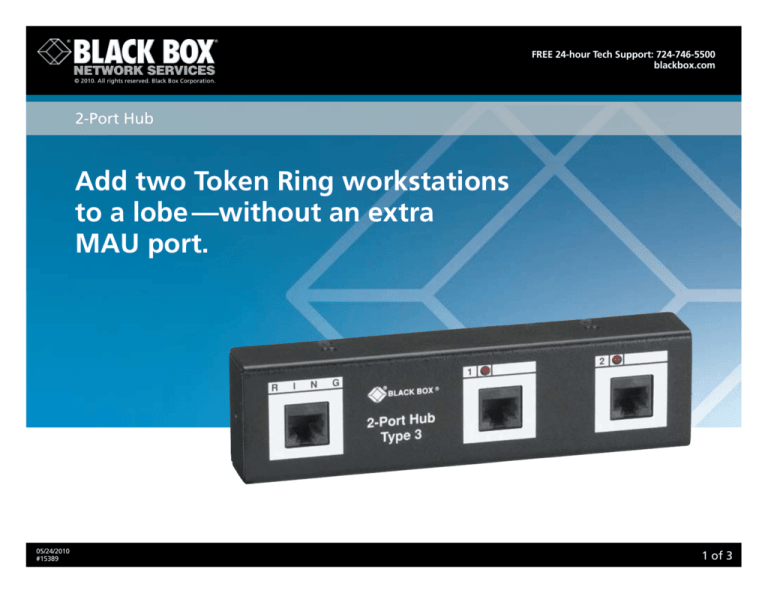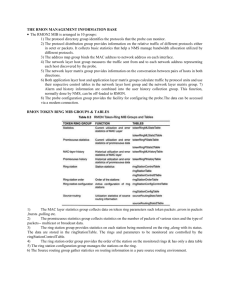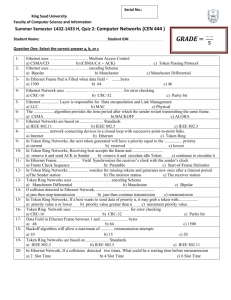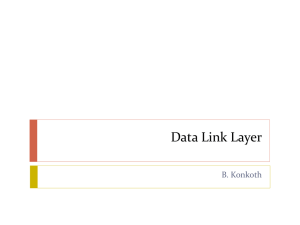
FRee 24-hour Tech support: 724-746-5500
blackbox.com
© 2010. All rights reserved. Black Box Corporation.
2-Port Hub
Add two Token Ring workstations
to a lobe —without an extra
MAU port.
05/24/2010
#15389
­­1 of 3
Tech SPecs
OVERVIEW
Features
Connect two workstations to one lobe.
»
» No extra MAU port needed.
» Hot-swappable. No downtime.
» Nonpowered—no external power supplies
required.
» Two models to choose from.
» Easily wallmounted with the included bracket.
The 2-Port Hub makes expanding your legacy Token Ring network
fast and easy by enabling you to double the capacity of a single
lobe—even when an extra MAU port isn’t available.
You can add or delete workstations without shutting down your
network, so you can move equipment while keeping your LAN up and
running and without the extra MAU—or extra expense—of a backup
ring.
Install the hub in just two easy steps. First, use a patch cable to
connect the hub’s ring port to your existing Token Ring outlet. Then
connect two workstations to Ports 1 and 2 of the hub. Because the
hub is a non­powered, passive device, there’s no need to plug it into
a power outlet.
The 2-Port Hub supports Type 3 Token Ring with unshiel­ded RJ-45
connections for Type 3 unshielded twisted-pair cable or with shielded
RJ-45 connections for Type 3 shielded twisted-pair cable.
The compact 2-Port Hub can be mounted on a wall with the included
bracket, so you can add workstations anywhere you need them.
Speed — 16 or 4 Mbps
Connectors — LT7001A: (3) Unshielded RJ-45;
LT7002A: (3) Shielded RJ-45
Indicators — LEDs: (2) Port Status (1 per port)
Power — Nonpowered
Size — 1.8"H x 6.5"W x 1"D (4.6 x 16.5 x 2.5 cm)
Weight — 0.5 lb. (0.2 kg)
Item
Code
2-Port Hub
Type 3 Unshielded
LT7001A
Type 3 Shielded
LT7002A
To connect your Token Ring network to Ethernet, order…
Ethernet to Token Ring Adapters (Device to Network)
TCP/IP Protocol for U.S. and U.K.
LBU9001-US
SPX (Novell) Protocol for U.S. and U.K.
LBU9002-US
Technically Speaking
About Token Ring.
Token Ring was developed in the early 1980s by IBM®. In
1985, the IEEE released document number 802.5, which formally
accepted Token Ring as a standard. Although its popularity has
been eclipsed by Ethernet, Token Ring is nonetheless a robust
networking standard and is still operating reliably in many legacy
networks.
Token Ring is most often used in IBM mainframe environ­
ments. IBM provides Token Ring connections on much of its
mainframe computer hardware, and its software enables PCs
and mainframes to act as peers on the same network.
The name “Token Ring“ is somewhat misleading. Although
its name implies a physical ring shape, Token Ring is actually a
star-based topology. Logically, the network operates as a ring—
“tokens“ bearing information are passed from node to node
until the token travels completely around the ring.
Token Ring networks are interconnected via passive and active
hubs called Multistation Access Units (MAUs). MAUs are the failsafe components of Token Ring networks. If a cable or
a connection goes bad, the MAU will drop that node from the
ring. This fail-safe hub arrangement prevents a break from taking
down the entire network. Ring-in/ring-out ports in each MAU can
05/24/2010
#15389
724-746-5500
be used to connect a ring to other rings.
Token Ring repeaters are used to extend distances within a
ring. Repeaters can increase either main-ring or lobe lengths in
a Token Ring LAN. The main-ring length is the distance between
MAUs. The lobe length is the distance from MAU to workstation.
Token Ring cabling.
The original Token Ring specifications called for shielded
twisted-pair (STP) cable using either a DB9 connector or a unique
square connector called the IBM data connector. Later, Token Ring
was adapted to use conventional unshielded twisted-pair (UTP)
cable with RJ-45 connectors. The most common kinds of Token
Ring cabling in use to day are Type 1 and Type 6 STP as well as
Type 3 UTP.
Type 1 shielded twisted-pair (STP) cable is the original wiring
for Token Ring. In Type 1 cabling, each wire is constructed of 22
AWG solid copper. Type 1 cable is not as flexible as Type 6 cable
and is generally used for long runs in areas where twists and turns
are less likely, such as in walls or conduits.
Type 6 Token Ring cable is a lighter, more pliable version of
Type 1 cable. It’s constructed of two stranded 26 AWG copper
pairs that are surrounded by an overall braided shield. Type 6
cable is commonly used in offices and open areas, and its flexible
blackbox.com
­­2 of 3
BLACK BOX
®
Technically Speaking
construction enables it to negotiate multiple twists and turns.
Type 3 or UTP Token Ring cabling uses the same twisted-pair
CAT3, CAT5, or CAT5e cabling with RJ-45 connectors as
10BASE-T Ethernet.
Attaching older Type 1 Token Ring to UTP Token Ring requires
a balun or adapter.
Two speeds.
LT7001A
Token Ring operates at either 4 or 16 Mbps. While you can
mix speeds within one network, each individual ring can operate
at just one speed. Simply put, you cannot have 4- and 16-Mbps
devices operating in one ring.
Migrating from Token Ring to Ethernet.
Although it’s proven to be reliable and fault-tolerant, Token
Ring has largely been supplanted by Ethernet, and Token Ring
network devices are no longer widely available. Additionally,
Ethernet LANs are less expensive to build and operate than
Token Ring, Ethernet can provide far greater bandwidth, and
many networking products simply do not support Token Ring
at all. The reality is that Token Ring is dying. Even IBM has
walked away from this standard.
For these reasons, system administrators usually choose to
migrate their legacy Token Ring networks to Ethernet by adding
new network segments as Ethernet rather than Token Ring.
There are three different ways to move from Token Ring
to Ethernet by interconnecting the networks. The method you
choose depends on whether you’re connecting a LAN or a WAN
and how much you want to spend.
Keep in mind that no matter how you connect the two net­
works, they both must use the same protocol. In other words,
they must speak the same language, such as IP or IPX™.
An economical way to combine Novell® IPX based Token Ring
and Ethernet networks is to have them share a server. Just install
either a Token Ring NIC in the Ethernet server or an Ethernet NIC
in the Token Ring server. Then change the server’s config­uration
to enable the internal router program. While this method is low
cost, it adds traffic and overhead to the server, which can
decrease overall network performance.
An easy, standalone hardware solution is to simply use an
Ethernet to Token Ring bridge such as a BLACK BOX® Ethernet to
Token Ring Adapter (LBU9001-US, LBU9002-US). Just connect the
bridge to your Token Ring MAU and your Ethernet hub and make
sure that both networks have the same network identification—in
essence, they will become one logical network. Also, since this is a
solution for LANs, both networks must be close to each other.
Another choice for connecting Token Ring and Ethernet is to
use a router to connect the two networks over a wide-area link.
The router enables each network to maintain its own unique
network identifier.
Why Buy From Black Box? Exceptional Value.
Exceptional Tech Support. Period.
Recognize any of these situations?
• You wait more than 30 minutes to get through
to a vendor’s tech support.
• The so-called “tech” can’t help you or gives you
the wrong answer.
• You don’t have a purchase order number and the
tech refuses to help you.
• It’s 9 p.m. and you need help, but your vendor’s
tech support line is closed.
05/24/2010
#15389
724-746-5500
According to a survey by Data Communi­cations magazine, 90%
of network managers surveyed say that getting the technical support
they need is extremely important when choosing a vendor. But even
though network managers pay anywhere from 10 to 20% of their
overall purchase price for a basic service and support contract, the
technical support and service they receive falls far short of their
expectations—and certainly isn’t worth what they paid.
At Black Box, we guarantee the best value and the best support.
You can even consult our Technical Support Experts before you buy if
you need help selecting just the right component for your application.
Don’t waste time and money—call Black Box today.
blackbox.com
­­3 of 3
BLACK BOX
®










